With the December Holidays here, many people may gift or receive some “Festive” holiday plants. In Florida, these plants can grow well beyond the holiday months! Learn about 5 commonly gifted plants and how to grow them year-round here in the Sunshine State.
Christmas Cactus
 This plant gets its name from its colorful showy blooms in December that often resemble ornaments on a Christmas tree! This plant can grow indoors or in containers outside during the warmer months. This cactus grows best in bright, indirect light and can be fertilized every 1-2 months during the growing season (April to September.) Because it a cactus, it prefers well drained soil and only needs to be watered when the soil feels dry. Learn more here: https://gardeningsolutions.ifas.ufl.edu/plants/houseplants/christmas-cactus.html
This plant gets its name from its colorful showy blooms in December that often resemble ornaments on a Christmas tree! This plant can grow indoors or in containers outside during the warmer months. This cactus grows best in bright, indirect light and can be fertilized every 1-2 months during the growing season (April to September.) Because it a cactus, it prefers well drained soil and only needs to be watered when the soil feels dry. Learn more here: https://gardeningsolutions.ifas.ufl.edu/plants/houseplants/christmas-cactus.html
Amaryllis
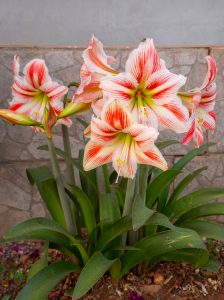 Another commonly gifted plant with large beautiful flowers is Amaryllis. Amaryllis comes in many colors and can grow multiple flowers per stock. This plant will go dormant at certain times of year, where the flowers will die back and leave just the green leaves behind. Instead of throwing out the plant, you can prune the flower to the base and this plant will flower again in the spring. However, if you receive a wax-dipped amaryllis bulb, enjoy the plant while in bloom, then you can peel off the wax and place it in a pot of well-drained soil. You can encourage early flowering by keeping at least one half to two-thirds of the bulb above the soil line It will eventually sprout roots and will rebloom! In Florida they can be planted outdoors between September and January, and will grow best if planted in a spot with partial sun and well-drained soil. Do not overwater your amaryllis bulb, as it can lead to root rot. Learn more here: https://gardeningsolutions.ifas.ufl.edu/plants/ornamentals/amaryllis.html
Another commonly gifted plant with large beautiful flowers is Amaryllis. Amaryllis comes in many colors and can grow multiple flowers per stock. This plant will go dormant at certain times of year, where the flowers will die back and leave just the green leaves behind. Instead of throwing out the plant, you can prune the flower to the base and this plant will flower again in the spring. However, if you receive a wax-dipped amaryllis bulb, enjoy the plant while in bloom, then you can peel off the wax and place it in a pot of well-drained soil. You can encourage early flowering by keeping at least one half to two-thirds of the bulb above the soil line It will eventually sprout roots and will rebloom! In Florida they can be planted outdoors between September and January, and will grow best if planted in a spot with partial sun and well-drained soil. Do not overwater your amaryllis bulb, as it can lead to root rot. Learn more here: https://gardeningsolutions.ifas.ufl.edu/plants/ornamentals/amaryllis.html
Rosemary
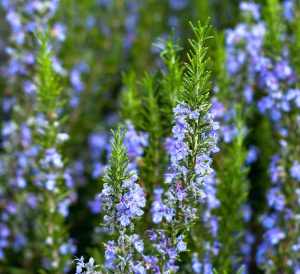
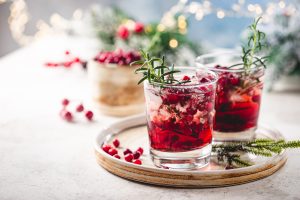 An herb perfect for a holiday feast or delicious beverage of choice, rosemary grows well in a pot here in central Florida! Rosemary grows great in a container or directly planted into your landscape. When selecting a site to grow Rosemary, look for an area that will receive at least 6 hours of sun, ensure it has well-drained soil, and be careful not to overwater. This plant can be difficult to germinate from seeds but propagates well from cuttings. Learn more here: https://gardeningsolutions.ifas.ufl.edu/plants/edibles/vegetables/rosemary.html
An herb perfect for a holiday feast or delicious beverage of choice, rosemary grows well in a pot here in central Florida! Rosemary grows great in a container or directly planted into your landscape. When selecting a site to grow Rosemary, look for an area that will receive at least 6 hours of sun, ensure it has well-drained soil, and be careful not to overwater. This plant can be difficult to germinate from seeds but propagates well from cuttings. Learn more here: https://gardeningsolutions.ifas.ufl.edu/plants/edibles/vegetables/rosemary.html
Mistletoe
 While associated with the holidays, this romantic plant is actually damaging in nature. Mistletoe is a parasitic plant that can weaken or destroy the trees it infests. So, while this isn’t a traditional plant you may gift or receive it is beneficial to the tree to remove it, so if you see mistletoe growing this holiday season, prune as much as you can to help the tree and use the clippings as holiday décor! The best management methods for controlling parasitic mistletoe is by carefully pruning it or having a licensed pest control operator apply a growth regulating chemicals. Learn more here: https://gardeningsolutions.ifas.ufl.edu/care/weeds-and-invasive-plants/mistletoe.html#:~:text=In%20Florida%2C%20mistletoe%20is%20most,our%20most%20beautiful%20southern%20butterflies
While associated with the holidays, this romantic plant is actually damaging in nature. Mistletoe is a parasitic plant that can weaken or destroy the trees it infests. So, while this isn’t a traditional plant you may gift or receive it is beneficial to the tree to remove it, so if you see mistletoe growing this holiday season, prune as much as you can to help the tree and use the clippings as holiday décor! The best management methods for controlling parasitic mistletoe is by carefully pruning it or having a licensed pest control operator apply a growth regulating chemicals. Learn more here: https://gardeningsolutions.ifas.ufl.edu/care/weeds-and-invasive-plants/mistletoe.html#:~:text=In%20Florida%2C%20mistletoe%20is%20most,our%20most%20beautiful%20southern%20butterflies
Poinsettia
 Poinsettia are one of the most popular December holiday plants because they make great gifts/decoration! The showy portions of the poinsettia, which most people think of as the flower, are actually colorful leaves called bracts. While you are probably familiar with this “holiday plant” did you know it can grow year-round? Whether you’re growing it in a pot indoors or planted directly in the ground, these plants can continue to grow with the proper care. They won’t maintain their vibrant color year round, but there are ways to manipulate the plant into reverting back to their colorful state again next year. The process is tricky but can make for a fun gardening challenge.
Poinsettia are one of the most popular December holiday plants because they make great gifts/decoration! The showy portions of the poinsettia, which most people think of as the flower, are actually colorful leaves called bracts. While you are probably familiar with this “holiday plant” did you know it can grow year-round? Whether you’re growing it in a pot indoors or planted directly in the ground, these plants can continue to grow with the proper care. They won’t maintain their vibrant color year round, but there are ways to manipulate the plant into reverting back to their colorful state again next year. The process is tricky but can make for a fun gardening challenge.
Keeping in a pot: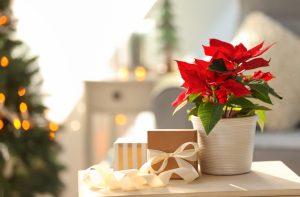
- 6 hours of direct sun light
- Water only when top-layer of soil is dry
- Once leaves and bracts begin to fall off, you can prune the plant. Then provide ample light, water, and fertilize every 4-6 weeks
- In order to reflower next year, starting in October, you’ll need to start placing the plant in complete darkness for 13-14 hours a day (consider placing in a dark closet or under a cabinet.) The remaining hours the plant will need bright light. A possible schedule could be placing it in a bright window from 8 am-6 pm then in a dark spot from 6 pm-8 am. After 2 months with this scheduled light requirement the plant will redevelop colorful blooms!
Planting in the landscape:
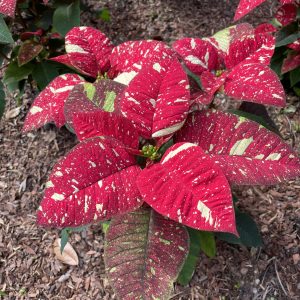
- Poinsettias can be planted in the ground in early spring, or once we’re past the last frost.
- Plant in a location that will get 3-6 hours of sun, but will not receive artificial light at night (such as a porch light or street light.)
- Once leaves and bracts begin to fade, you can prune them back to about 4-6 inches.
- Poinsettias want well drained soil with a pH of 5.5-6.5.
- Prune as needed throughout the year, leaving at least 4 leaves per stem. After September allow plant to flush out for a gorgeous December display.
Learn more here: https://gardeningsolutions.ifas.ufl.edu/pdf/poinsettias_pointers.pdf



